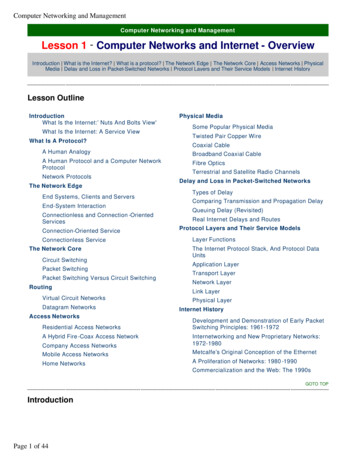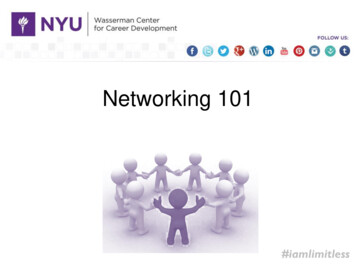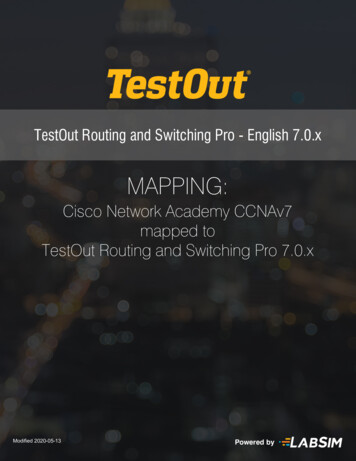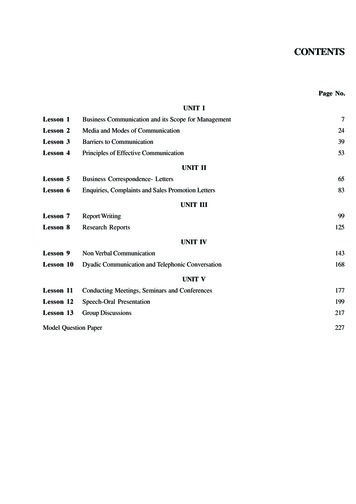
Transcription
Computer Networking and ManagementComputer Networking and ManagementLesson 1 - Computer Networks and Internet - OverviewIntroduction What is the Internet? What is a protocol? The Network Edge The Network Core Access Networks PhysicalMedia Delay and Loss in Packet-Switched Networks Protocol Layers and Their Service Models Internet HistoryLesson OutlineIntroductionWhat Is the Internet:’ Nuts And Bolts View'What Is the Internet: A Service ViewWhat Is A Protocol?Physical MediaSome Popular Physical MediaTwisted Pair Copper WireCoaxial CableA Human AnalogyBroadband Coaxial CableA Human Protocol and a Computer NetworkProtocolFibre OpticsNetwork ProtocolsThe Network EdgeEnd Systems, Clients and ServersEnd-System InteractionConnectionless and Connection -OrientedServicesConnection-Oriented ServiceConnectionless ServiceThe Network CoreCircuit SwitchingPacket SwitchingPacket Switching Versus Circuit SwitchingRoutingVirtual Circuit NetworksDatagram NetworksAccess NetworksResidential Access NetworksA Hybrid Fire -Coax Access NetworkTerrestrial and Satellite Radio ChannelsDelay and Loss in Packet-Switched NetworksTypes of DelayComparing Transmission and Propagation DelayQueuing Delay (Revisited)Real Internet Delays and RoutesProtocol Layers and Their Service ModelsLayer FunctionsThe Internet Protocol Stack, And Protocol DataUnitsApplication LayerTransport LayerNetwork LayerLink LayerPhysical LayerInternet HistoryDevelopment and Demonstration of Early PacketSwitching Principles: 1961-1972Company Access NetworksInternetworking and New Proprietary Networks:1972-1980Mobile Access NetworksMetcalfe’s Original Conception of the EthernetHome NetworksA Proliferation of Networks: 1980 -1990Commercialization and the Web: The 1990sGOTO TOPIntroductionPage 1 of 44
Computer Networking and ManagementThis lesson provides a broad overview of the Computer Networking and the Internet. The lesson begins with anoverview of the Internet and of networking protocols, introducing several key terms and concepts.We examine the 'edge' of a computer network, looking at the end systems and applications, and at thetransport service provided to applications running of the end systemsWe also examine the 'core' of a computer network, examining the links and switches that transport data. Wethen take a broader view of networking. From a performance standpoint, we study the causes of packet delayand loss in computer network. We identify key architectural principles in networking, including layering andservice models. We provide brief introduction history of computer networking.Finally, we provide a brief overview of ATM, a networking technology that provides an important contrast withInternet technologies.GOTO TOPWhat is the Internet?Here we use the public Internet, a specific computer network, as our principle vehiclefor discussing computer networking protocols. But what is the Internet?We would like to be able to give you a one-sentence definition of the Internet – adefinition that you can take home and share with your family and friends. Alas, theInternet is very complex, both in terms of its hardware and software components, aswell as in the services it provides.GOTO TOPWhat is the Internet: ‘Nuts and Bolts’ ViewPage 2 of 44
Computer Networking and ManagementInstead of giving a one sentencedefinition, let us try a more descriptiveapproach. There are a couple of ways todo this. One way is to describe the nutsand bolts of the Internet, that is, thebasic hardware and softwarecomponents that make up the Internet.Another way is to describe the Internetin terms of a networking infrastructurethat provides services to distributedapplications.Cool Internet AppliancesLG's Internet t Touch Screen Tablethttp://www.x-home.com/e/e43.htmlJCC's iBOX-2 with Geode and Linux 9.htmlDigital Photo Receiverhttp://www.ceiva.comThe public internet is a worldwide computer network, that is, a network that interconnects millions of computingdevices throughout the world. Most of these computing devices are traditional desktop PCs, Unix -basedworkstations, and so called servers that store and transmit information such as Web (WWW) pages and e-mailPage 3 of 44
Computer Networking and Managementmessages. Increasingly, non-traditional computing devices such as Web TVs, mobile computers, pagers, andtoasters are being connected to the Internet.In the Internet jargon, all of these devices are called hosts or end systems. The Internet applications, withwhich many of us are familiar, such as the Web and e-mail, are network application programs that run on suchend systems.End systems, as well as most other ‘pieces ’ of the Internet, run protocols thatcontrol the sending and receiving of information within the Internet. TCP(Transmission Control Protocol) and IP (Internet Protocol) are two of the mostimportant protocols in the Internet. The Internet ’s principal protocols arecollectively known as TCP/IP.End systems are connected together by communication links. Links are made upof different types of physical media, including coaxial cable, copper wire, fibreoptics, and radio spectrum. Different links can transmit data at different rates. Thelink transmission rate is often called the link bandwidth and is typically measuredin bits/second.Usually, end systems are not directly attached to eachother via a single communication link. Instead, they areindirectly connected to each other through intermediateswitching devices known as routers. A router takesinformation arriving on one of its incoming communication links and then forwardsthat information on one of its outgoing communication links. The IP protocolspecifies the format of the information that is sent and received among routersand end systems. The path that transmitted information takes from the sendingend system, through a series of communications links and routers, to thereceiving end system is known as a route or path through the network.Rather than provide a dedicated path between communicating end systems, theInternet uses a technique known as packet switching that allows multiplecommunicating end systems to share a path, or parts of a path, at the same time.The earliest ancestors of the Internet were the first packet-switched networks.The Internet is really a network of networks. That is, the Internet is aninterconnected set of privately and publicly owned and managed networks. Anynetwork connected to the Internet must run the IP protocol and conform to certainnaming and addressing conventions. Other than these few constraints, however,a network operator can configure and run its network (that is, its little piece ofInternet) however it chooses. Because of the universal use of the IP protocol inthe Internet, the IP protocol is sometimes referred to as the Internet dial tone.The topology of the Internet, that is, the structure of the interconnection amongthe various pieces of the internet, is loosely hierarchical. Roughly speaking, frombottom-to -top, the hierarchy consists of end systems connected to local InternetService Providers (ISPs) through access networks. An access network may be aso-called local-area network within a company or university, a dial telephone linewith a modem, or a high-speed cable -based or phone -based access network.Local ISPs are in turn connected to regional ISPs, which are in turn connected tonational and international ISPs. The national and international ISPs are connectedtogether at the highest tier in the hierarchy. New tiers and branches (that is, newnetworks, and new networks of networks) can be added.Things to Remember:What is the Internet?millions of connectedcomputing devices: hosts,end-systemsllPCs,workstations,serversPDAs phones,toasters,running networkappscommunication linkslfiber, copper, radio,satelliteltransmission rate bandwidthrouters: forward packets(chunks of data)Things to Remember:What is the Internet?protocols control sending,receiving of msgse.g., TCP, IP, HTTP, FTP,PPPInternet: “network ofnetworks”lloosely hierarchicallpublic Internetversus privateintranetInternet standardsllRFC: Request forcommentsIETF: InternetEngineering TaskForceAt the technical and developmental level, the Internet is made possible throughcreation, testing, and implementation of Internet standards. These standards aredeveloped by the Internet Engineering Task Force (IETF).The IETF standards documents are called Request For Comments (RFCs). RFCs started out as generalrequest for comments (hence the name) to resolve architecture problems that faced the precursor to theInternet. RFCs, though not formally standards, have evolved to the point where they are cited as such. RFCstend to be quite technical and detailed. They define protocols such as TCP, IP, HTTP (for the web), and SMTP(for open-standards e-mail). There are more than 2,000 different RFCs.Page 4 of 44
Computer Networking and ManagementThe public Internet is the network that one typically refers to as the Internet. There are also many privatenetworks, such as certain corporate and government networks, whose hosts are not accessible from (that is,they cannot exchange messages with) hosts outside of that private network. These private networks are oftenreferred to as intranets, as they often use the same Internet technology (for example, the same types of host,routers, links, protocols, and standards) as the public Internet.The preceding discussion has identified many of the pieces that make up the Internet.Let us now leave the nuts -and -bolts description and take a more abstract service -oriented view.GOTO TOPWhat is the Internet: A Service ViewThe Internet allows distributed applications running on its end systems toexchange data with each other. These applications include remote login, filetransfer, electronic mail, audio and video streaming, real -time audio and videoconferencing, distributed games, the World Wide Web, and much, muchmore.It is worth emphasizing that the Web is not a separate network but rather justone of many distributed applications that use the communication servicesprovided by the Internet. The Web could also run over a network besides theInternet. One reason that the Internet is the communication medium of choicefor the Web, however, is that no other existing packet switched network connects more than 100 millioncomputers together and has over 350 million users.Cyberspace [Gibson]:“a consensual hallucination experienced daily by billions of operators, in every nation,."The Internet provides two services to its distributed applications: a connectionoriented service and a connectionless oriented service.Loosely speaking, connection -oriented service guarantees that data transmittedfrom a sender to a receiver will eventually be delivered to the receiver in order andits entirety.Connectionless service does not make any guarantees about eventual delivery.Typically, a distributed application makes use of one or the other of these twoservices and not both.Things to Remember:Communicationinfrastructure enablesdistributed applications:lWeblemailgamesllCurrently, the Internet does not provide a service that makes promises about howlong it will take to deliver the data from sender to receiver. Also, except forincreasing your access bit rate to your Internet service provider, you currentlycannot obtain better service (for example, shorter delays) by paying more.Our second description of the Internet – in terms of the services it provides todistributed applications – is a non-traditional, but important, one. Increasingly,advances in the nuts-and-bolts components of the Internet are being driven by theneeds of new applications. So it is important to keep in mind that the Internet is aninfrastructure in which new applications are being constantly invented anddeployed.le-commercedatabasevotinglfile (MP3) sharinglCommunication servicesprovided to apps:llconnectionlessconnection-orientedWe have given two descriptions of the Internet, one in terms of its hardware andsoftware components, the other in terms of the services it provides to distributedapplications.GOTO TOPWhat is a Protocol?Page 5 of 44
Computer Networking and ManagementNow that we have got a bit of a feel for what the Internet is, let us consider another important buzzword incomputer networking – protocol.What is a protocol? What does a protocol do? How would you recognize a protocol if you met one?human protocols:“what’s the time? ”“I have a question ”introductionsnetwork protocols:machines rather than humansall communication activity in Internetgoverned by protocols specific msgs sent specific actions taken when msgsreceived, or other eventsprotocols define format, order of msgs sent and received among network entities, andactions taken on msg transmission, receiptGOTO TOPA Human AnalogyIt is probably easiest to understand the notion of a computer network protocol by first considering some humananalogies, since we humans execute protocols all of the time. Consider what you do when you ask someonefor the time of day.A typical exchange is shown in the following diagram. Human protocol dictates that one first offers a greeting(the first “Hi” in Figure) to initiate communication with someone else. The typical response to a “HI” message(at least outside of New York City) is a returned “Hi” message. Implicitly, one takes a cordial “Hi” response asan indication that one can proceed ahead and ask for the time of day. A different response to the initial“Hi” (such as “Don ’t bother me!” or “I don’t speak English, ” or an unprintable reply that one might receive inNew York City) might indicate an unwillingness or inability to communicate.a human protocol and a computer network protocol:Page 6 of 44
Computer Networking and ManagementIn this case, the human protocol would be to not ask for the time of day. Sometimes one gets no response at allto a question, in which case one typically gives up asking that person for the time.Note that in our human protocol, there are specific messages we send, and specific actions we take inresponse to the received reply messages or other events (such as no reply within some given amount of time).Clearly transmitted and received messages, and actions taken when these messages are sent or received orother events occur, play a central role in human protocol.If people run different protocols (for example, if one person has manners but the other does not, or if oneunderstands the concept of time and the other does not) the protocols do not interoperate and no useful workcan be accomplished. The same is true in networking – it takes two (or more) communicating entities runningthe same protocol in order to accomplish a task.GOTO TOPA Human Protocol and a Computer Network ProtocolLet us consider a second human analogy. Suppose you are in a college class (acomputer networking and management class, for example!). The teacher is droningon about protocols and you are confused.The teacher stops to ask, "Are there any questions?" (a message that is transmittedto, and received by, all students who are not sleeping!). You raise your hand(transmitting an implicit message to the teacher).Your teacher acknowledges you with a smile, saying "Yes. ." (a transmitted message encouraging you to askyour question -teachers love to be asked questions) and you then ask your question (that is, transmit yourmessage to your teacher).Your teacher hears your question (receives your question message) and answers (transmits a reply to you).Once again, we see that the transmission and receipt of messages, and a set of conventional actions takenwhen these messages are sent and received, are at the heart of this question -and -answer protocol.GOTO TOPNetwork ProtocolsA network protocol is similar to a human protocol, except that the entities exchanging messages and takingPage 7 of 44
Computer Networking and Managementactions are hardware or software components of a computer network. All activity in the Internet that involvestwo or more communicating remote entities is governed by a protocol.Protocols in routers determine a packet's path from source to destination; hardware - implemented protocols inthe network interface cards of two physically connected computers control the flow of bits on the 'wire' betweenthe two computers; a congestion - control protocol controls the rate at which packets are transmitted betweensender and receiver.Protocols are running everywhere in the Internet, and consequently much of this module is about computernetwork protocols.As an example of a computer network protocol with which you are probably familiar, consider what happenswhen you make a request to a Web server, that is, when you type in the URL of a Web page into your Webbrowser.lFirst, your computer will send a 'connection request' message to the Web server and wait for a reply.The Web server will eventually receive your connection request message and return a 'connection reply'message.lKnowing that it is now OK to request the Web document, your computer then sends the name of theWeb page it wants to fetch from that Web server in a 'get' message.lFinally, the Web server returns the contents of the Web document to your computer.Given the human and networking examples above, the exchange of messages and the actions taken whenthese messages are sent and received are the key defining elements of a protocol:A protocol defines the format and the order of messages exchanged between two ormore communicating entities, as well as the actions taken on the transmission and/orreceipt of a message or other event.The Internet and computer networks in general, make extensive use of protocols. Different protocols are usedto accomplish different communication tasks.GOTO TOPA closer look at network structurelNetwork edge:¡llapplications and hostsNetwork core :¡routers¡network of networksAccess networks, physical media:¡communication linksIn the previous sections we presented a high-level description of the Internet and networking protocols. We arenow going to delve a bit more deeply into the components of the Internet. We begin in this section at the edgeof network and look at the components with which we are most familiar -the computers (for example, PCs andworkstations) that we use on a daily basis. In the next section we will move from the network edge to thenetwork core and examine switching and routing in computer networks. Then we will discuss the actualphysical links that carry the signals sent between the computers and the switches.GOTO TOPThe Network EdgePage 8 of 44
Computer Networking and ManagementGOTO TOPEnd Systems, Clients, and ServersIn computer networking jargon, the computers that we use on a daily basis areoften referred to as hosts or end systems. They are referred to as hosts becausethey host (run) application-level programs such as a Web browser or serverprogram, or an e -mail program. They are also referred to as end systems becausethey sit at the edge of the Internet, as shown in Visual 10. Throughout this modulewe will use the terms hosts and end systems interchangeably; that is, host endsystem.Things to Remember:End systems (hosts):llrun applicationprogramse.g., WWW, emaillat "edge of network"GOTO TOPEnd-System InteractionHosts are sometimes further divided into two categories: clients and servers.Informally, clients often tend to be desktop PCs or workstations, whereas serversare more powerful machines. But there is a more precise meaning of a client anda server in computer networking.In the so -called client/servermodel, a client program runningon one end system requestsand receives information from aserver running on another endsystem. This client/server modelis undoubtedly the mostprevalent structure for Internetapplications.The Web, e-mail, file transfer, remote login (for example, Telnet), newsgroups,and many other popular applications adopt the client/server model. Since a clienttypically runs on one computer and the server runs on another computer,client/server Internet applications are, by definition, distributed applications. Theclient and the server interact with each other by communicating (that is, sendingeach other message) over the Internet.At this level of abstraction, the routers, links and other 'pieces' of the Internetserve as a 'black box' that transfers messages between the distributed,Page 9 of 44Things to Remember:Client/server model:lclient host requests,receives servicefrom serverle.g. Webbrowser/server;email client/serverPeer-peer model:llhost interactionsymmetrice.g.: Gnutella,KaZaA
Computer Networking and Managementcommunicating components of an Internet application.Computers (for example, a PC or a workstation), operating as clientsand servers, are the most prevalent type of end system. However, anincreasing number of alternative devices, such as so-called networkcomputers and thin clients, Web TV s and set top boxes, digitalcameras, etc. are being attached to the Internet as end systems.GOTO TOPConnection less and Connection-Oriented ServicesWe have seen that end systems exchange messages with each other according to an application-level protocolin order to accomplish some task. The links, routers, and other pieces of the Internet provide the means totransport these messages between the end - system applications. But what are the characteristics of thecommunication services that are provided? The Internet, and more generally TCP/IP networks, provides twotypes of services to its applications: connection less service and connection-oriented service.A developer creating an Internet application (for example, an e-mail application, a file transfer application, aWeb application, or an Internet phone application) must program the application to use one of these twoservices.GOTO TOPConnection-Oriented ServiceWhen an application uses the connection-oriented service, the client and theserver (residing in different end systems) send control packets to each otherbefore sending packets with real data (such as e-mail messages). This so-calledhandshaking procedure alerts the client and server, allowing them to prepare foran onslaught of packets. It is interesting to note that this initial handshakingprocedure is similar to the protocol used in human interaction.The exchange of "Hi's" we saw is an example of a human'handshaking protocol' (even though handshaking is not literallytaking place between the two people). The two TCP messagesthat are exchanged as part of the WWW interaction detailed inthe above visual are two of the three messages exchangedwhen TCP sets up a connection between a sender and receiver.The third TCP message (not shown) that forms the final part ofthe TCP three-way handshake is contained in the get message shown in theabove diagram.Things to Remember:Goal : data transferbetween end systemsHandshaking: setup(prepare for) data transferahead of timellHello, hello backhuman protocolset up .state" in twocommunicatinghostsTCP -Transmission ControlProtocol - Internet'sconnection oriented serviceOnce the handshaking procedure is finished, a connection is said to beestablished between the two end systems. But the two end systems areconnected in a very loose manner, hence the terminology connection-oriented. Inparticular, only the end systems themselves are aware of this connection; thepacket switches (that is, routers) within the Internet are completely oblivious to theconnection. This is because a TCP connection consists of nothing more thanallocated resources (buffers) and state variables in the end systems. The packetswitches do not maintain any connection-state information.The Internet's connection-oriented service comes bundled with several other services, including reliable datatransfer, flow control, and congestion control. By reliable data transfer, we mean that an application can rely onthe connection to deliver all of its data without error and in the proper order.Reliability in the Internet is achieved through the use of acknowledgements and retransmissions. To get apreliminary idea about how the Internet implements the reliable transport service, consider an application thathas established a connection between end systems A and B:Page 10 of 44
Computer Networking and ManagementlWhen end system B receives a packet from A, it sends an acknowledgement; when end system Areceives the acknowledgement, it knows that the corresponding packet has definitely been received.lWhen end system A doesn't receive an acknowledgement, it assumes that the packet it sent was notreceived by B; it therefore retransmits the packet.Flow control makes sure that neither side of a connection overwhelms the other side by sending too manypackets too fast. Indeed, the application at one side of the connection may not be able to process informationas quickly as it receives the information. Therefore, there is a risk of overwhelming either side of an application.The flow -control service forces the sending end system to reduce its rate whenever there is such a risk. Weshall see that the Internet implements the flow control service by using sender and receiver buffers in thecommunicating end systems. The Internet's congestion-control service helps prevent the Internet from enteringa state of gridlock.When a router becomes congested, its buffers can overflow and packet loss can occur. In such circumstances,if every pair of communicating end systems continues to pump packets into the network as fast as they can,gridlock sets in and few packets are delivered to their destinations. The Internet avoids this problem by forcingend systems to decrease the rate at which they send packets into the network during periods of congestion.End systems are alerted to the existence of severe congestion when they stop receiving acknowledgements forthe packets they have sent.We emphasize here that although the Internet's connection-oriented servicecomes bundled with reliable data transfer, flow control, and congestion control,these three features are by no means essential components of a connectionoriented service. A different type of computer network may provide a connectionoriented service to its applications without bundling in one or more of thesefeatures. Indeed, any protocol that performs handshaking between thecommunicating entities before transferring data is a connection-oriented service.The Internet's connection-oriented service has a name -TCP (TransmissionControl Protocol); the initial version of the TCP protocol is defined in the InternetRequest for Comments RFC 793 [RFC 793]. The services that TCP provides toan application include reliable transport, flow control, and congestion control. It isimportant to note that an application need only care about the services that areprovided; it need not worry about how TCP actually implements reliability, flowcontrol, or congestion control.Things to Remember:TCP service [RfC 793]Reliable, in-order bytestream data transfer :acknowledgements andretransmissionsFlow control: sender won'toverwhelm receiverCongestion control: senders“slow down sending rate"when network congestedGOTO TOPConnection Less ServiceThere is no handshaking with the Internet's connectionless service. When oneside of an application wants to send packets to another side of an application, thesending application simply sends the packets. Since there is no handshakingprocedure prior to the transmission of the packets, data can be delivered faster.But there are no acknowledgements either, so a source never knows for surewhich packets arrive at the destination. Moreover, the service makes no provisionfor flow control or congestion control. The Internet's connectionless service isprovided by User Datagram Protocol (UDP); UDP is defined in the Internet RFC768.Most of the more familiar Internet applications use TCP, the Internet's connection oriented service. These applications include Telnet (remote login), SMTP (forelectronic mail), FTP (for file transfer), and HTTP (for the Web). Nevertheless,UDP, the Internet's connectionless service, is used by many applications,including many of the emerging multimedia applications, such as Internet phone,audio-on-demand, and video conferencing.Things to Remember:UDP - User DatagramProtocol [RFC 768]:Unreliable data transferNo flow controlNo congestion controlApplications using TCP:HTTP (WWW), FTP (FileTransfer),Telnet (remotelogin), SMTP (email)Applications using UDP:Streaming media,Teleconferencing,InternettelephonyGOTO TOPPage 11 of 44
Computer Networking and ManagementThe Network CoreThere are two fundamental approaches towards building a network core: circuit switching and packetswitching. In circuit-switched networks, the resources needed along a path (buffers, link bandwidth) to providefor communication between the end systems are reserved for the duration of the session. In packet -switchednetworks, these resources are not reserved; a session's messages use the resource on demand, and as aconsequence, may have to wait (that is, queue) for access to a communication linkAs a simple analogy, consider two restaurants -one that requires reservations andanother that neither requires reservations nor accepts them. For the restaurantthat requires reservations, we have to go through the hassle of first calling beforewe leave home. But when we arrive at the restaurant we can, in principle,immediately communicate with the waiter and order our meal. For the restaurantthat does not require reservations, we don't need to bother to reserve a table. Butwhen we arrive at the restaurant, we may have to wait for a table before we cancommunicate with the waiter.Telephone networks are examples of circuit-switched networks. Consider whathappens when one person wants to send information (voice or facsimile) toanother over a telephone network. Before the sender can send t
This lesson provides a broad overview of the Computer Networking and the Internet. The lesson begins with an overview of the Internet and of networking protocols, introducing several key terms and concepts. We examine the 'edge' of a computer network










